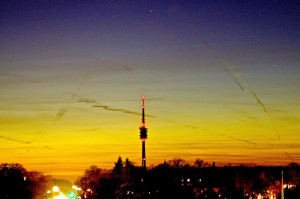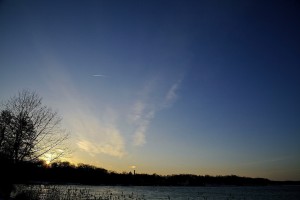January 26, 2014: Frozen Lakeshore After Freezing Nights
There wasn’t much winter till the midst of January 2014 in middle Europe. But then two pressure systems began struggling for dominance over Germany, which lasts still end of January. Even over weeks there is now a division between low pressure in the west and high pressure in the east. Temperatures began to drop below zero after Sunday, January 19, with the air mass boundary moving a bit to the west.
A dangerous situation happened during the night between 19-20 January in Berlin and Brandenburg: freezing rain felt on frozen ground. In the morning hours not only many traffic accidents occurred but fire starters had not enough ambulances to transport all the injured people who slipped and had broken legs or arms. Fire engines were employed to transport people to hospital.
This situation improved on Tuesday when snow began to fall. From day to day temperatures dropped in the East whereas temperature conditions in the west were still moderate.
On Friday night it became really cold and on Sunday, January 26, temperatures in Potsdam (near Berlin) fell below -20C. This led to interesting ice sculptures at the frozen lakeshores in the same area:


 Sunday was sunny for most of the time with some dust in the air, which was a good condition for making photos. The good weather condition lasted till Monday when snow began to fall. On rivers and lakes more and more ice floes can be seen now. It’s possible that even big lakes in North-East Germany will be completely covered by ice soon. Often people then start to skate very soon on these lakes. However any kind of river is dangerous, and in Berlin lakes like the Wannsee lake or the lakes around Potsdam are parts of the giant river system of the river Havel, which means there are always strong currents in these lakes. This makes the ice often unpredictable and can lead to very dangerous accidents as you can’t see how thick the ice sheet really is. Strong winds also play a role for the development of the ice sheet.
Sunday was sunny for most of the time with some dust in the air, which was a good condition for making photos. The good weather condition lasted till Monday when snow began to fall. On rivers and lakes more and more ice floes can be seen now. It’s possible that even big lakes in North-East Germany will be completely covered by ice soon. Often people then start to skate very soon on these lakes. However any kind of river is dangerous, and in Berlin lakes like the Wannsee lake or the lakes around Potsdam are parts of the giant river system of the river Havel, which means there are always strong currents in these lakes. This makes the ice often unpredictable and can lead to very dangerous accidents as you can’t see how thick the ice sheet really is. Strong winds also play a role for the development of the ice sheet. 


It’s particularly interesting to see what happens at a shore of a lake or the sea when temperatures drop and water begins to become ice. Here the floes are making some funny noises.
http://youtu.be/oueggEgBiVo








